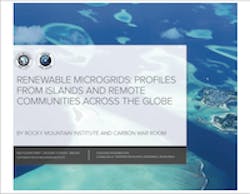The livelihoods of individuals and families living on islands and in remote communities across the globe are directly tied to the availability and price of one volatile global commodity: oil. While oil is also used for various purposes in larger communities across the globe, islands and remote communities are disproportionately dependent on oil for their well-being. In these communities, oil powers the way people move. It propels the ships and trucks that bring in goods from the outside. It enables the tourism industry that keeps many of these local economies afloat. It also powers the electricity system in most of these communities. For well over 100 years, oil has enabled remote communities to generate electricity and enjoy the benefits of a consistent electrical supply. However, unlike many larger, non-isolated communities across the globe that are increasingly turning to a diverse supply of resources to generate electricity, most islands and remote communities continue to rely on oil and oil alone for their electricity and other energy needs. These risks and drawbacks—paired with continuing cost reductions in solar, wind, and energy storage technologies—suggest that an alternative to the fully oil-based electricity systems of the past is now available to islands and remote communities across the globe: affordable renewable microgrids.
